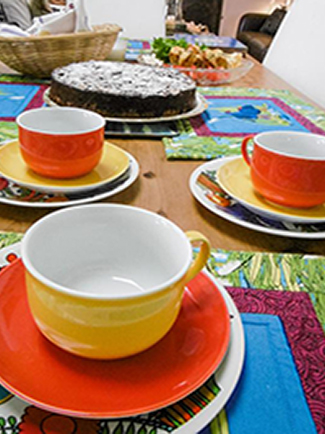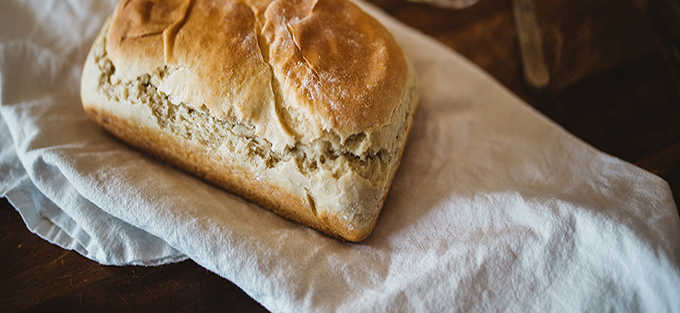by Jenna Pulkowski Huntsberger
When I was a teen, my family attended a congregation that wasn’t a very good fit for us. One of my most vivid memories of that congregation is that only little kids were allowed to have food and drink in the sanctuary.

On the rare occasions when I was allowed to bring a water bottle into worship, I was calmer. I could concentrate on worshiping God, enjoying the harmonies of the hymns, and following my pastor’s sermons. A bottle of drinking water: such a simple thing.
Many of us take pleasure in the beauty of our church sanctuary and are careful to keep our worship space neat and clean. Bringing food and drink into the worship space can feel almost sacrilegious. After all, worship is where we are spiritually fed, not where we eat our breakfast, right?
But both physical hunger and spiritual hunger are deep human needs. What does this mean for us?
Jesus brought others to the table
Early followers of Jesus met at meals, where they literally broke bread together. The body and blood of Christ, present in the bread and wine of the Eucharist, shaped how they gathered around the table to nourish both bodies and souls.
The Apostle Paul reminded the community in Corinth that their meals were not just for the purpose of stuffing themselves, especially when each person brought only enough food for their own meal. Some even got drunk while others left the table hungry and thirsty. His words are especially strong in 1 Corinthians 11:17-22, where he admonishes the believers for the ways their coming together causes further division.
In our own time and place, many churches continue to find common ground over a shared meal. Usually this means a potluck, Advent or Lent soup suppers, spaghetti fundraisers, Valentine’s Day dinners and any number of other events. But how often do we mean God’s meal when we talk about food at church? What will inspire us to think about the Eucharist when we discuss food in the sanctuary?
We most often call the table on which the elements sit the altar, because it is where we make our offerings to God. Yet it is also very much a table like the ones we have in our kitchens and dining rooms. Places for food can be places of pain and suffering, and of life and transformation.
 When I think of tables, I think of the places where friends, families, strangers, acquaintances and even enemies sit down to share a meal and then leave transformed by the stories they shared and heard. They are the places that gather us in so that we might be fed and filled for the day’s work that awaits us or where we might be painfully reminded that there is nothing for us to do. Tables that have plenty and tables that are sparse remind us that so many people have nothing on their tables.
When I think of tables, I think of the places where friends, families, strangers, acquaintances and even enemies sit down to share a meal and then leave transformed by the stories they shared and heard. They are the places that gather us in so that we might be fed and filled for the day’s work that awaits us or where we might be painfully reminded that there is nothing for us to do. Tables that have plenty and tables that are sparse remind us that so many people have nothing on their tables.
It’s amazing to see how so many communities embrace the ways in which God feeds us and we feed others.
In seminary, we had a basket for our food offerings, and it would be brought forward along with the communion elements and our financial offerings. Many churches do food drives, volunteer at food pantries, cook meals at homeless shelters, have the youth groups put together boxes for homeless neighbors, and serve community meals. Food, meals and worship continue to be central to the ways in which we connect with one another.
At God’s table, God puts out only the best, most wholesome meal. God’s table is where we arrive hungry and thirsty, and we leave fed and filled with the reminder that God’s grace and love are always with us. At God’s table, beloveds who have been at odds with one another will be fed and nourished with God’s grace.
When we eat at God’s table, we leave transformed. The bread and the wine may not be enough to fill us up, but nevertheless we are filled.
The sanctuary is a holy place, but I don’t think it is any more holy than the kitchen, or the youth room, or even the boiler room (although it’s probably a bit tidier). Every space in our churches and in our lives has been claimed and sanctified by God.
We worship God and God is not limited to any particular space. As we seek to emulate Christ, emboldened by the Holy Spirit, may we rest soundly in the knowledge that cookies, bagels and coffee in the sanctuary are just some of the ways we can deepen our welcome and more fully love one another.
I don’t mind when I see people bringing their coffee into the sanctuary or reaching into a bag for a granola bar. I find it especially charming when someone steps out of worship and returns with fellowship-hour cookie crumbs on their shirt.
Time for a fresh cup of coffee!
Discussion questions:
1. When you think of food and worship, what are some of the first things to come to mind?
2. What are some memories you have that are associated with tables? Family meals, school lunches, field trips, food courts, hospital cafeterias – where are some of the places you have gathered to eat?
3. What are some ways you and your congregation incorporate food into worship? What are some other ways you might do so?
Closing prayer:
Holy and gracious God, thank you for all the ways in which you feed us. We especially thank you for your open and welcoming table, where all are welcome. Help us to use your gracious, life-giving meal to better serve you, and to share your love with others. In Jesus’ name, strengthened by the Holy Spirit and nourished with your grace, we pray. Amen.
Jenna, a graduate of the Lutheran School of Theology at Chicago, is an ordained pastor in the ELCA. Her and her husband, along with their fur baby, recently moved back to Chicago, where she is currently serving as interim chaplain at St. Pauls House. She loves to eat and pretty much always has a snack in her bag, “just in case.”


I have cough varient asthma, and a hot cup of coffee or tea will help to prevent a coughing fit. One Sunday, visiting my in laws, and attending a different Lutheran church, I stopped for a cup of coffee on my way. I had already used my inhaler and knew the hot liquid and caffeine would help. I was sternly stopped from entering the church, with my coffee, by an usher. I sat outside on the steps drinking my coffee, feeling very annoyed and unwanted. I know the usher had no idea I had asthma. Back home, I commented to my pastor husband, that had that been my first church experience, it would be a long time before I went to church again.